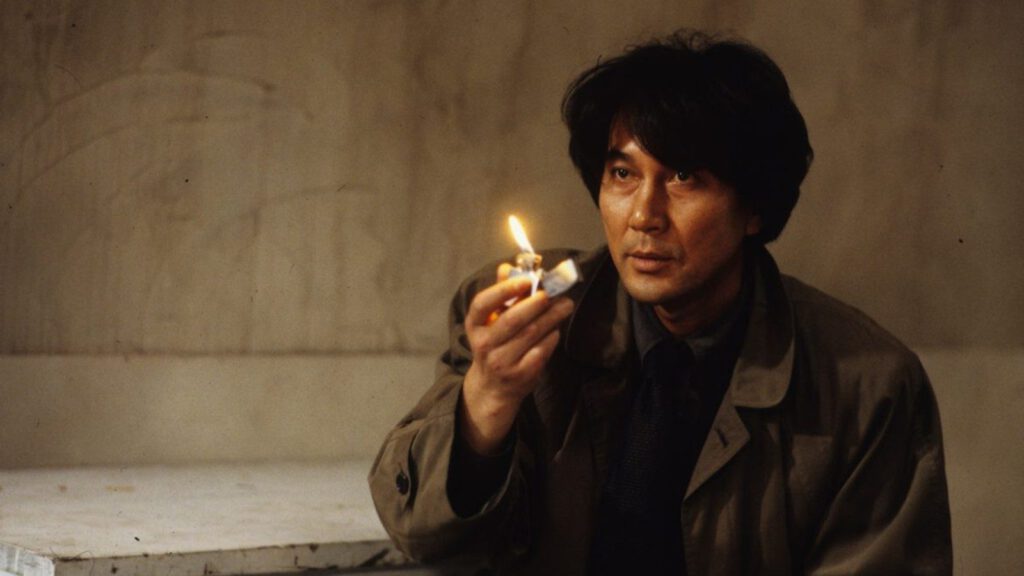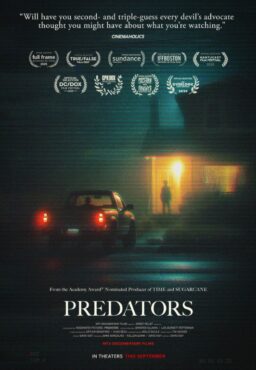Kiyoshi Kurosawa’s 1997 film “Cure,” whose 4K restoration version was released in South Korean theaters this July and distributed by the Criterion Collection several months later, is an unnerving, creepy masterwork that will haunt you in more than one way. “Cure” gradually immerses you into its subtle but undeniably ominous atmosphere once you go along with its rather twisty journey into darkness, and you will find yourself chilled much more than expected around the movie’s final shot.
In the beginning, “Cure” puts us right into a bizarre case of serial killings which has baffled a detective named Takabe (Kōji Yakusho) and his colleagues. In each incident, a seemingly normal citizen has suddenly committed a brutal act of killing in an uncannily identical pattern. Though they willingly confess what they did, the murderers do not know or remember what motivated them, even though they are all horrified by what they committed. In addition, there isn’t a noticeable connection among the victims at all except a certain simple but disturbing mark carved on their upper bodies, another confounding detail of Takabe’s case.
While Takabe and Sakuma (Tsuyoshi Ujiki), a psychologist who is also Takabe’s close friend, keep searching for anything common among these gruesome murders, the movie shows us what’s happening on the opposite side. We are introduced to a mysterious lad named Mamiya (Masato Hagiwara), and cinematographer Tokushô Kikumura’s camera follows how this elusive young dude works upon his latest target shortly after a seemingly accidental encounter between them on a remote beach. On the surface, Mamiya seems to be suffering some odd case of amnesia besides an apparent communication problem. His latest target, a young married schoolteacher, willingly lets Mamiya stay at his residence just because he wants to help as any decent person would.
However, once he enters the schoolteacher’s cozy house, Mamiya slowly and ominously reveals his true colors. Besides being increasingly passive-aggressive, he keeps asking the schoolteacher to tell more about his life, and the mood becomes all the more unnerving with a small act of his. Regardless of whatever is happening between them, this subtly tense scene feels all the more disturbing in its plain mundane setting. We are then shocked but not so surprised by what happens next between the schoolteacher and his wife.
Alternating between Takabe’s ongoing investigation and Mamiya’s rather random wandering, the movie gives us a series of memorable moments which mainly strike us with uttermost detachment. In the case of one particular scene, the camera remains static while merely looking at what is about to happen in front of a small police station. We then brace ourselves even though everything in the background feels merely normal on the screen.
The following interrogation scene, which gives Takabe and Sakuma what may be the first significant lead for their case, is phlegmatic but intense. At first, we watch several performers in this scene simply occupying a closed space. The camera stays static as usual, but the mood becomes alarming as Takabe and Sakuma interrogate their latest perpetrator step by step. Takabe does something risky despite his friend’s caution, and the result leads him to a certain possibility. Is it possible that all those perpetrators in the case were under a sort of evil influence? If so, how could that be possible?
Delving more into this dark possibility, Takabe subsequently finds himself becoming much more agitated than before for no apparent reason. When he eventually confronts Mamiya later in the story, there’s something about Mamiya that frustrates and disturbs Takabe a lot, and it makes Takabe more obsessed with whatever Mamiya is doing behind his decidedly blank appearance. Regardless of whether he’s an amnesiac or not, Mamiya enjoys toying with not only Takabe but also others, including his bosses. There is a darkly amusing moment when he makes them at a loss without revealing anything about him at all.
It seems quite possible that Mamiya somehow found some diabolical method to manipulate others’ minds, but, steadily refusing to give us any easy answer, the movie indirectly suggests something a lot darker. On one hand, he may be just a very smart and twisted lad who was inspired by a certain old psychological method from some obscure European psychologist in the 19th century. On the other hand, he also can be an entity beyond our understanding which is much more frightening than he looks on the surface. (“All the things that used to be inside of me … now they are all outside.”).
In the meantime, the movie focuses more on Takabe’s psychological implosion. Several early scenes in the film already show us the growing estrangement between him and his wife who has some serious mental problems; the anxiety beneath their rather barren domestic life is often amplified by the recurring sound of an empty washing machine. While she needs more help than her routine visit to her psychiatrist, it’s apparent that he also needs some rest and therapy. There is a very striking scene in the middle of the story where sudden jump cuts are used for the depiction of his sudden mental breakdown.
As Takabe struggles more and more with the influence of his maddeningly impenetrable suspect, the movie eventually becomes a social horror fable. It subtly implies that Mamiya’s frequent question functions as some kind of trigger for all that personal anger and discontent suppressed in the name of social conformity and normalcy; Takabe eventually comes to confront his darkness like any other flawed hero of noir thriller films. Kōji Yakusho, an ever-reliable Japanese actor who recently gave another good performance in Miwa Nishikawa’s “Under the Open Sky” (2020), palpably conveys to us the growing psychological crisis behind his character’s glum and detached façade. Masato Hagiwara is an effective counterpart for Yakusho, deftly handling his very tricky role.
I must point out that the finale is quite ambiguous with some unresolved story elements. I am not sure what exactly Sakuma comes to learn during the last act, though I appreciate how he serves as a sort of voice of reason for Takabe. I also cannot explain a certain brief scene supposedly involving with Takabe’s wife, which is placed right before the very end of the film.
Nevertheless, the movie still holds our attention to the end. I must confess that I am still scratching my head on how to process and interpret its last scene, but I admire how effortlessly Kurosawa delivers its underlying dramatic impact. Looking back at what is presented during the following end credits, it’s somehow much creepier than before.
“Cure” can be an acquired taste, but its distinctive creepiness and unconventional storytelling is mesmerizing. Although some of Kurosawa’s later works such as “Tokyo Sonata” (2008) and “Wife of a Spy” (2020) are more accessible in comparison, “Cure” has considerably influenced several notable filmmakers around the world, including Oscar-winning South Korean filmmaker Bong Joon-ho. Even after 25 years, “Cure” exudes a dark and insidious power.











